Conformational Analysis of N-Alkyl-N-[2-(diphenylphosphoryl)ethyl]amides of Diphenylphosphorylacetic Acid: Dipole Moments, IR Spectroscopy, DFT Study
Abstract
1. Introduction
2. Results and Discussion
2.1. Methodology
2.2. Polarity of Phosphorylacetamides 1–3
2.3. Experimental and Theoretical Conformational Analysis of Phosphorylacetamides 1–3
3. Materials and Methods
3.1. Materials
3.2. IR Spectroscopy
3.3. Dipole Moments
3.4. Quantum Chemical Calculations
4. Conclusions
Supplementary Materials
Author Contributions
Funding
Institutional Review Board Statement
Informed Consent Statement
Conflicts of Interest
Sample Availability
References
- Turanov, A.N.; Karandashev, V.K.; Artyushin, O.I.; Peregudov, A.S.; Khvostikov, V.A.; Bondarenko, N.A. Extraction Properties of Diphenyl{[N-(2-diphenylphosphinylethyl)-N-alkyl]carbamoylmethyl}phosphine Oxides in Nitric Acid Solutions. Russ. J. Inorg. Chem. 2020, 65, 905–913. [Google Scholar] [CrossRef]
- Turanov, A.N.; Karandashev, V.K.; Kharlamov, A.V.; Bondarenko, N.A.; Khvostikov, V.A. Extraction of lanthanides(III) from Perchlorate Solutions with Carbamoyl- and Phosphorylmethoxymethylphosphine Oxides and Tetrabutyldiglycolamide. Solvent Extr. Ion Exch. 2019, 37, 65–80. [Google Scholar] [CrossRef]
- Turanov, A.N.; Karandashev, V.K.; Yarkevich, A.N.; Khvostikov, V.A. Extraction of REE(III), U(VI), and Th(IV) from Nitric Acid Solutions with Diphenyl(dibutylcarbamoylmethyl)phosphine Oxide in the Presence of Quaternary Ammonium Bis[(trifluoromethyl)sulfonyl]imides. Radiochemistry 2019, 61, 694–699. [Google Scholar] [CrossRef]
- Turanov, A.N.; Karandashev, V.K.; Yarkevich, A.N.; Khvostikov, V.A. Extraction of Rare Earth Elements from Hydrochloric Acid Solutions with Carbamoylmethylphosphine Oxides in the Presence of Quaternary Ammonium Dinonylnaphthalenesulfonates. Russ. J. Inorg. Chem. 2019, 64, 822–827. [Google Scholar] [CrossRef]
- Werner, E.J.; Biros, S.M. Supramolecular ligands for the extraction of lanthanide and actinide ions. Org. Chem. Front. 2019, 6, 2067–2094. [Google Scholar] [CrossRef]
- Turanov, A.N.; Karandashev, V.K.; Yarkevich, A.N. Extraction of REE(III), U(VI), and Th(IV) from Nitric Acid Solutions with Carbamoylmethylphosphine Oxides in the Presence of Bis[(trifluoromethyl)sulfonyl]imide Ions. Radiochemistry 2018, 60, 170–176. [Google Scholar] [CrossRef]
- Turanov, A.N.; Karandashev, V.K.; Yarkevich, A.N. Extraction of Rare-Earth Elements from Hydrochloric Acid by Carbamoyl Methyl Phosphine Oxides in the Presence of Ionic Liquids. Russ. J. Inorg. Chem. 2018, 63, 406–413. [Google Scholar] [CrossRef]
- Leoncini, A.; Huskens, J.; Verboom, W. Ligands for f-element extraction used in the nuclear fuel cycle. Chem. Soc. Rev. 2017, 46, 7229–7273. [Google Scholar] [CrossRef]
- Turanov, A.N.; Karandashev, V.K.; Vinogradova, N.M.; Sharova, E.V.; Artyushin, O.I. Extraction Properties of P(O)-Modified N-Aryl-Carbamoylmethylphosphine Oxides in Nitric Acid Media. Solvent Extr. Ion Exch. 2014, 32, 408–423. [Google Scholar] [CrossRef]
- Odinets, I.L.; Artyushin, O.I.; Sharova, E.V.; Matveeva, E.V.; Turanov, A.N.; Karandashev, V.K. Extraction Properties of Oligodentate Carbamoylmethylphosphine Oxides and β-Aminophosphine Oxides Toward Lanthanides and Rhenium(VII). Phosphorus Sulfur Silicon Relat. Elem. 2013, 188, 146–149. [Google Scholar] [CrossRef]
- Turanov, A.N.; Karandashev, V.K.; Yarkevich, A.N. Extraction of REEs(III), U(VI), and Th(IV) from nitric acid solutions with carbamoylmethylphosphine oxides in the presence of an ionic liquid. Radiochemistry 2013, 55, 382–387. [Google Scholar] [CrossRef]
- Pitchaiah, K.C.; Sujatha, K.; Rao, C.V.S.B.; Subramaniam, S.; Sivaraman, N.; Rao, P.R.V. Supercritical fluid extraction of uranium and thorium from nitric acid medium using organophosphorous compounds. Radiochim. Acta 2015, 103, 245–255. [Google Scholar] [CrossRef]
- Sujatha, K.; Pitchaiah, K.; Sivaraman, N.; Nagarajan, K.; Srinivasan, T.; Rao, P.V. Recovery of plutonium from polymeric waste matrices using supercritical fluid extraction. Desalin. Water Treat. 2013, 52, 470–475. [Google Scholar] [CrossRef]
- Sasaki, Y.; Kitatsuji, Y.; Sugo, Y.; Tsubata, Y.; Kimura, T.; Morita, Y. Actinides Extractability Trends for Multidentate Diamides and Phosphine Oxides. Solvent Extr. Res. Dev. Jpn. 2012, 19, 51–61. [Google Scholar] [CrossRef][Green Version]
- Lumetta, G.J.; Gelis, A.V.; Vandegrift, G.F. Review: Solvent Systems Combining Neutral and Acidic Extractants for Separating Trivalent Lanthanides from the Transuranic Elements. Solvent Extr. Ion Exch. 2010, 28, 287–312. [Google Scholar] [CrossRef]
- Alyapyshev, M.Y.; Babain, V.; Ustynyuk, Y.A. Recovery of minor actinides from high-level wastes: Modern trends. Russ. Chem. Rev. 2016, 85, 943–961. [Google Scholar] [CrossRef]
- Sharova, E.V.; Artyushin, O.I.; Nelyubina, Y.V.; Lyssenko, K.; Passechnik, M.P.; Odinets, I.L. Complexation of N-alkyl(aryl)- and N,N-dialkylcarbamoylmethylphosphine oxides with the f-elements. Russ. Chem. Bull. 2008, 57, 1890–1896. [Google Scholar] [CrossRef]
- Horwitz, E.P.; Schulz, W.W. The Truex Process: A Vital Tool for Disposal of U.S. Defense Nuclear Waste. In New Separation Chemistry Techniques for Radioactive Waste and Other Specific Applications; Springer: Dordrecht, The Netherlands, 1991; pp. 21–29. [Google Scholar]
- Sharova, E.V.; IArtyushin, O.; Odinets, I.L. Synthetic routes to carbamoylmethylphosphoryl compounds—Extractants for the processing of spent nuclear fuels. Russ. Chem. Rev. 2014, 83, 95–119. [Google Scholar] [CrossRef]
- Myasoedov, B.F.; Kalmykov, S.N.; Kulyako, Y.M.; Vinokurov, S.E. Nuclear fuel cycle and its impact on the environment. Geochem. Int. 2016, 54, 1156–1167. [Google Scholar] [CrossRef]
- Ustynyuk, Y.A.; Alyapyshev, M.Y.; Babain, V.; Ustynyuk, N.A. Quantum chemical modelling of extraction separation of minor actinides and lanthanides: The state of the art. Russ. Chem. Rev. 2016, 85, 917–942. [Google Scholar] [CrossRef]
- Kameník, J.; Šebesta, F.; John, J.; Böhmer, V.; Rudzevich, V.; Grüner, B. Polyacrylonitrile based composite materials with extracting agents containing chemically bonded CMPO groups for separation of actinoids. J. Radioanal. Nucl. Chem. 2015, 304, 313–319. [Google Scholar] [CrossRef]
- Kameník, J.; Šebesta, F. Study of europium and selected actinides uptake on composite material CMPO-PAN. Czechoslov. J. Phys. 2006, 56, D493–D500. [Google Scholar] [CrossRef]
- Annam, S.; Rao, C.B.; Sivaraman, N.; Sivaramakrishna, A.; Vijayakrishna, K. Carbamoylmethylphosphine oxide functionalised porous crosslinked polymers towards sequential separation of uranium (VI) and thorium (IV). React. Funct. Polym. 2018, 131, 203–210. [Google Scholar] [CrossRef]
- Yarkevich, A.N.; Safronova, Z.V.; Petrova, L.N.; Gabrelyan, A.V.; Zamoyski, V.L.; Grigor’Ev, V.V.; Bachurin, S.O.; Zefirov, N.S. Physiologically active bis(dialkylamides) of phosphoryl-substituted α,ω-dicarboxylic acids. Russ. J. Gen. Chem. 2013, 83, 41–45. [Google Scholar] [CrossRef]
- Yarkevich, A.N.; Brel, V.; Makhaeva, G.F.; Serebryakova, O.; Boltneva, N.; Kovaleva, N. Synthesis and investigation of biological activity of phosphorylated amines and amides. Russ. J. Gen. Chem. 2015, 85, 1644–1649. [Google Scholar] [CrossRef]
- Artem’Ev, A.V.; Berezin, A.S.; Brel, V.K.; Morgalyuk, V.P.; Samsonenko, D.G. Deep-red phosphorescent organic–inorganic hybrid Mn(II) complexes based on 2-(diphenylphosphoryl)-N,N-diethylacetamide ligand. Polyhedron 2018, 148, 184–188. [Google Scholar] [CrossRef]
- Vasil’Ev, A.A.; Aleksenko, V.Y.; Aleksanyan, D.V.; Kozlov, V.A. Catalytic activity of k3-X,N,Y-palladium pincer complexes (X, Y = O, S) with (thio)phosphoryl-substituted carbamoylmethylphosphine oxide and sulfide ligands in the Suzuki cross-coupling. Mendeleev Commun. 2013, 23, 344–346. [Google Scholar] [CrossRef]
- Caudle, L.; Duesler, E.; Paine, R. Formation and crystal and molecular structures of dioxouranium(VI) complexes containing bidentate carbamoylmethylphosphinate and phosphine oxide ligands. Inorg. Chim. Acta 1985, 110, 91–100. [Google Scholar] [CrossRef]
- Caudle, L.J.; Duesler, E.N.; Paine, R.T. Preparation and structure of a neodymium complex containing bidentate (carbamoylmethyl)phosphine oxide ligands. Inorg. Chem. 1985, 24, 4441–4444. [Google Scholar] [CrossRef]
- Rosario-Amorin, D.; Dehaudt, J.; Caudle, L.J.; Dickie, D.; Paine, R.T. Synthesis and molecular structures of mercury(II) complexes of carbamoylmethylphosphoryl ligands. Phosphorus Sulfur Silicon Relat. Elem. 2016, 191, 520–526. [Google Scholar] [CrossRef]
- Antipin, M.Y.; Struchkov, Y.T.; Matrosov, E.I.; Kabachnik, M.I. Structure of organophosphorus compounds. Part XXX. X-ray structural investigation of diphenyl(diethylcarbamoylmethyl) phosphine oxide Ph2P(O)CH2C(O)NEt2 and its molecular complex with perchloric acid Ph2P(O)CH2C(O_NEt2·HClO4. J. Struct. Chem. 1985, 26, 441–446. [Google Scholar] [CrossRef]
- Das, D.; Sivaramakrishna, A.; Gopakumar, G.; Rao, C.B.; Sivaraman, N.; Vijayakrishna, K. Diphenylmorpholine CMPO: Synthesis, coordination behavior and extraction studies of actinides. Polyhedron 2018, 141, 215–222. [Google Scholar] [CrossRef]
- Yaftian, M.R.; Hassanzadeh, L.; Eshraghi, M.E.; Matt, D. Solvent extraction of thorium (IV) and europium (III) ions by diphenyl-N,N-dimethylcarbamoylmethylphosphine oxide from aqueous nitrate media. Sep. Purif. Technol. 2003, 31, 261–268. [Google Scholar] [CrossRef]
- Aleksenko, V.Y.; Sharova, E.V.; Artyushin, O.I.; Aleksanyan, D.V.; Klemenkova, Z.S.; Nelyubina, Y.V.; Petrovskii, P.V.; Kozlov, V.A.; Odinets, I.L. Coordination of P(X)-modified (X=O, S) N-aryl-carbamoylmethylphosphine oxides and sulfides with Pd(II) and Re(I) ions: Facile formation of 6,6-membered pincer complexes featuring atropisomerism. Polyhedron 2013, 51, 168–179. [Google Scholar] [CrossRef]
- Vereshchagina, Y.A.; Khanafieva, R.R.; Chachkov, D.V.; Artyushin, O.I.; Sharova, E.V.; Ishmaeva, E.A. Polarity and structure of P(X)-modified (X = O, S) arylcarbamoylmethylphosphine oxides and sulfides. Russ. J. Org. Chem. 2016, 52, 1413–1418. [Google Scholar] [CrossRef]
- Bondarenko, N.A.; Belus’, S.K.; Artyushin, O.I.; Peregudov, A.S. New Tridentate Carbamoylmethylphosphine Oxides: Synthesis and NMR Spectra. Russ. J. Gen. Chem. 2020, 90, 2273–2280. [Google Scholar] [CrossRef]
- Osipov, O.A.; Minkin, V.I.; Garnovskii, A. Spravochnik po dipol’nym momentam. In Handbook of Dipole Moments; Publishing House Vysshaya Shkola: Moscow, Russia, 1971; p. 416. [Google Scholar]
- Kuznetsova, A.A.; Ismagilova, R.R.; Chachkov, D.V.; Belogorlova, N.A.; Malysheva, S.F.; Vereshchagina, Y.A. Experimental and Theoretical Conformational Analysis of Tris(4-methylphenyl)phosphine and Its Chalcogenides. Russ. J. Org. Chem. 2020, 56, 2098–2103. [Google Scholar] [CrossRef]
- Medvedev, M.G.; Bushmarinov, I.S.; Sun, J.; Perdew, J.P.; Lyssenko, K.A. Density functional theory is straying from the path toward the exact functional. Science 2017, 355, 49–52. [Google Scholar] [CrossRef]
- Ishmaeva, E.A.; Timosheva, A.P.; Timosheva, N.V.; Vereshchagina, Y.A. Spravochnik po dipol’nym momentam fosfororganicheskih soedinenii. In Handbook of Dipole Moments of Organophosphorus Compounds; Publishing House of Kazan University: Kazan, Russia, 1998; p. 120. [Google Scholar]
- Johnson, R. Computational Chemistry Comparison and Benchmark Database (CCCBDB). Available online: https://cccbdb.nist.gov/ (accessed on 4 August 2021).
- Guggenheim, E.A. A proposed simplification in the procedure for computing electric dipole moments. Trans. Faraday Soc. 1949, 45, 714–720. [Google Scholar] [CrossRef]
- Smith, J.W. Some developments of Guggenheim’s simplified procedure for computing electric dipole moments. Trans. Faraday Soc. 1950, 46, 394–399. [Google Scholar] [CrossRef]
- Zimin, M.G.; Galeeva, R.M.; Pudovik, A.N. Dipole moments of organophosphorus compounds. Russ. Chem. Bull. 1971, 20, 473–477. [Google Scholar] [CrossRef]
- Gribov, L.A.; Popov, E.M. Valence-optical method and theoretical investigation of intensities and polarizations of fundamentals of polyatomic molecules in absorption spectra. Dokl. Akad. Nauk. SSSR 1962, 145, 761–763. [Google Scholar]
- Becke, A.D. Density-functional thermochemistry. III. The role of exact exchange. J. Chem. Phys. 1993, 98, 5648–5652. [Google Scholar] [CrossRef]
- Perdew, J.P.; Burke, K.; Wang, Y. Generalized gradient approximation for the exchange-correlation hole of a many-electron system. Phys. Rev. B 1996, 54, 16533–16539. [Google Scholar] [CrossRef] [PubMed]
- McLean, A.D.; Chandler, G.S. Contracted Gaussian basis sets for molecular calculations. I. Second row atoms, Z = 11–18. J. Chem. Phys. 1980, 72, 5639–5648. [Google Scholar] [CrossRef]
- Frisch, M.J.; Trucks, G.W.; Schlegel, H.B.; Scuseria, G.E.; Robb, M.A.; Cheeseman, J.R.; Scalmani, G.; Barone, V.; Mennucci, B.; Petersson, G.A.; et al. Gaussian 09; Gaussian, Inc.: Wallingford, CT, USA, 2009. [Google Scholar]
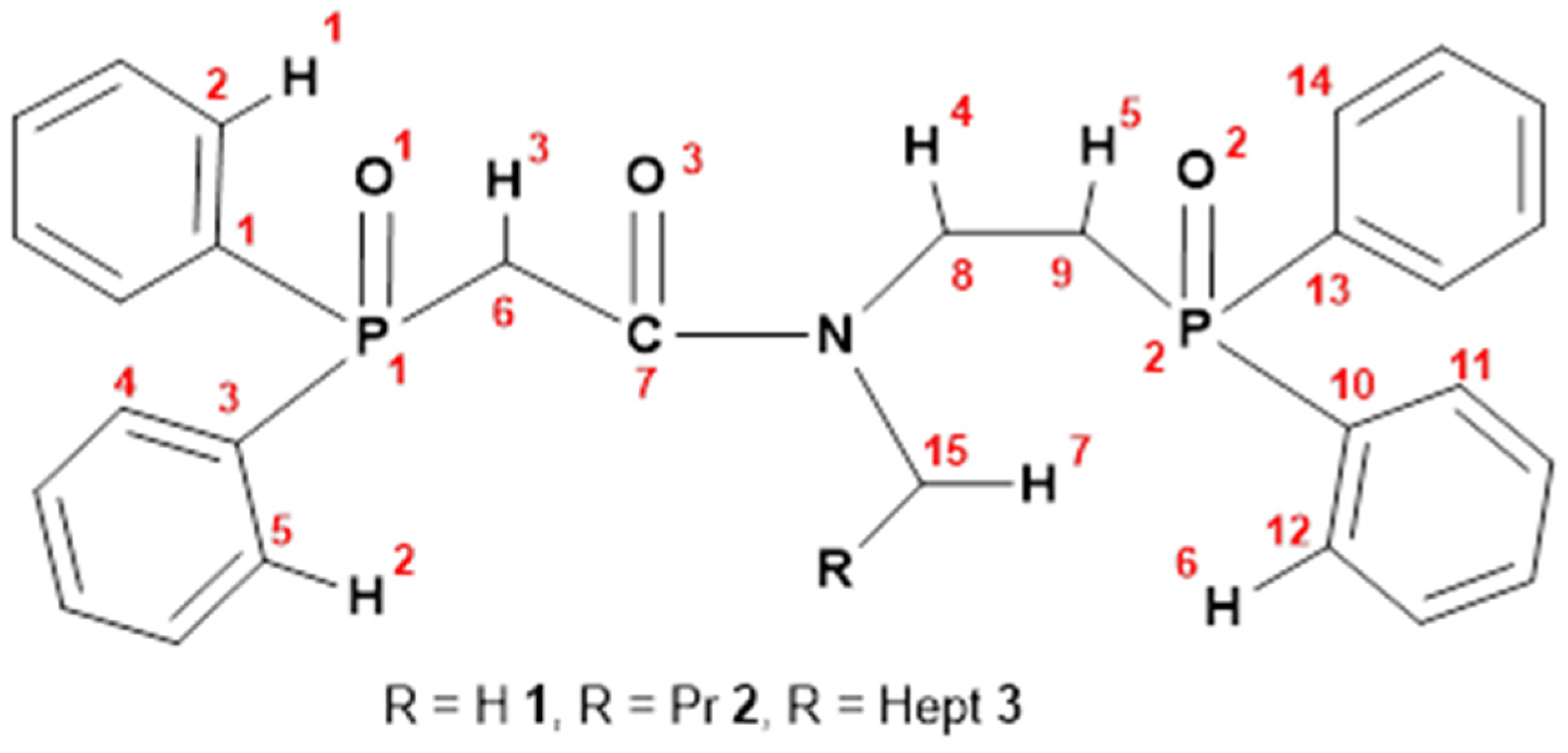
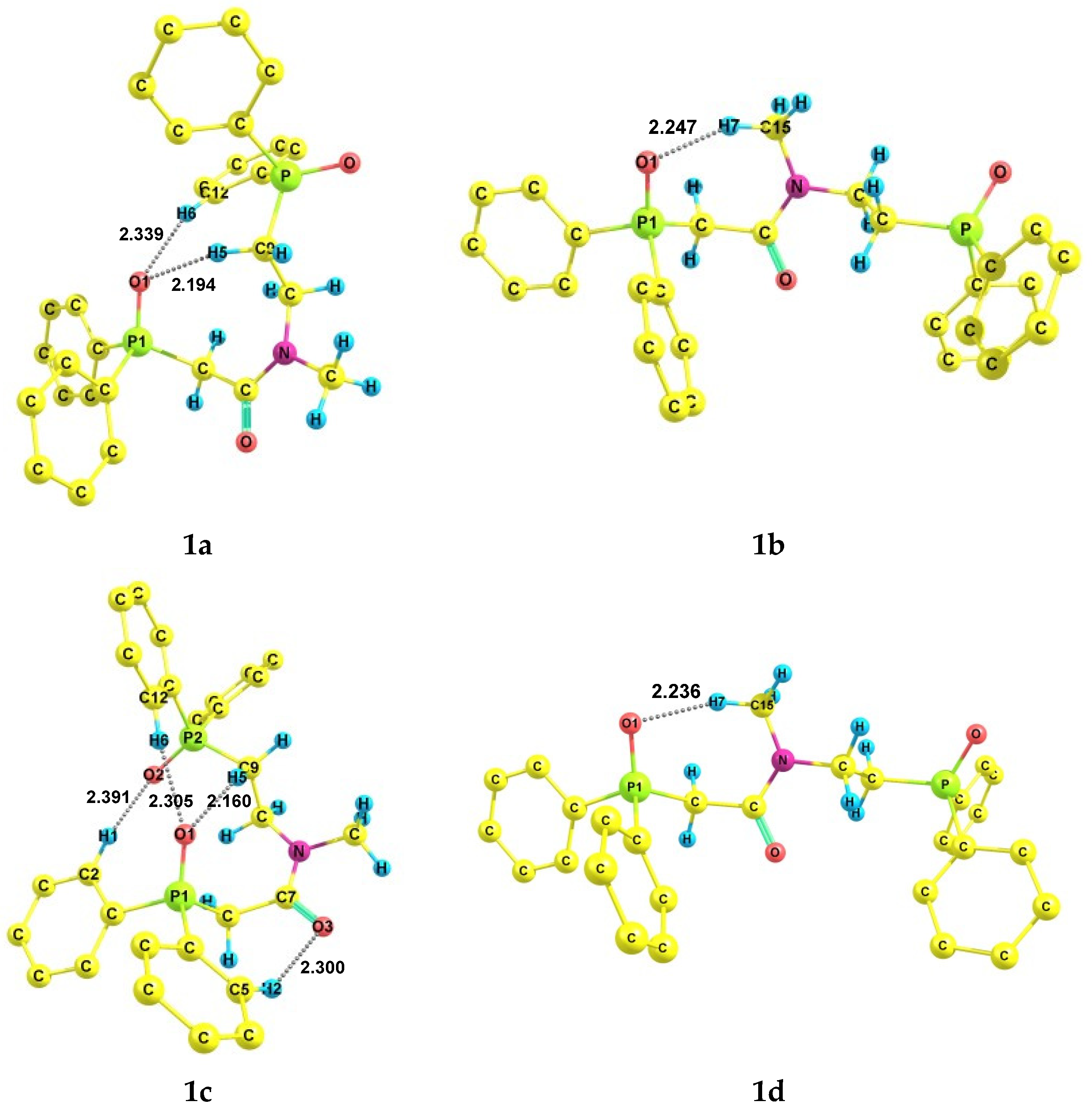
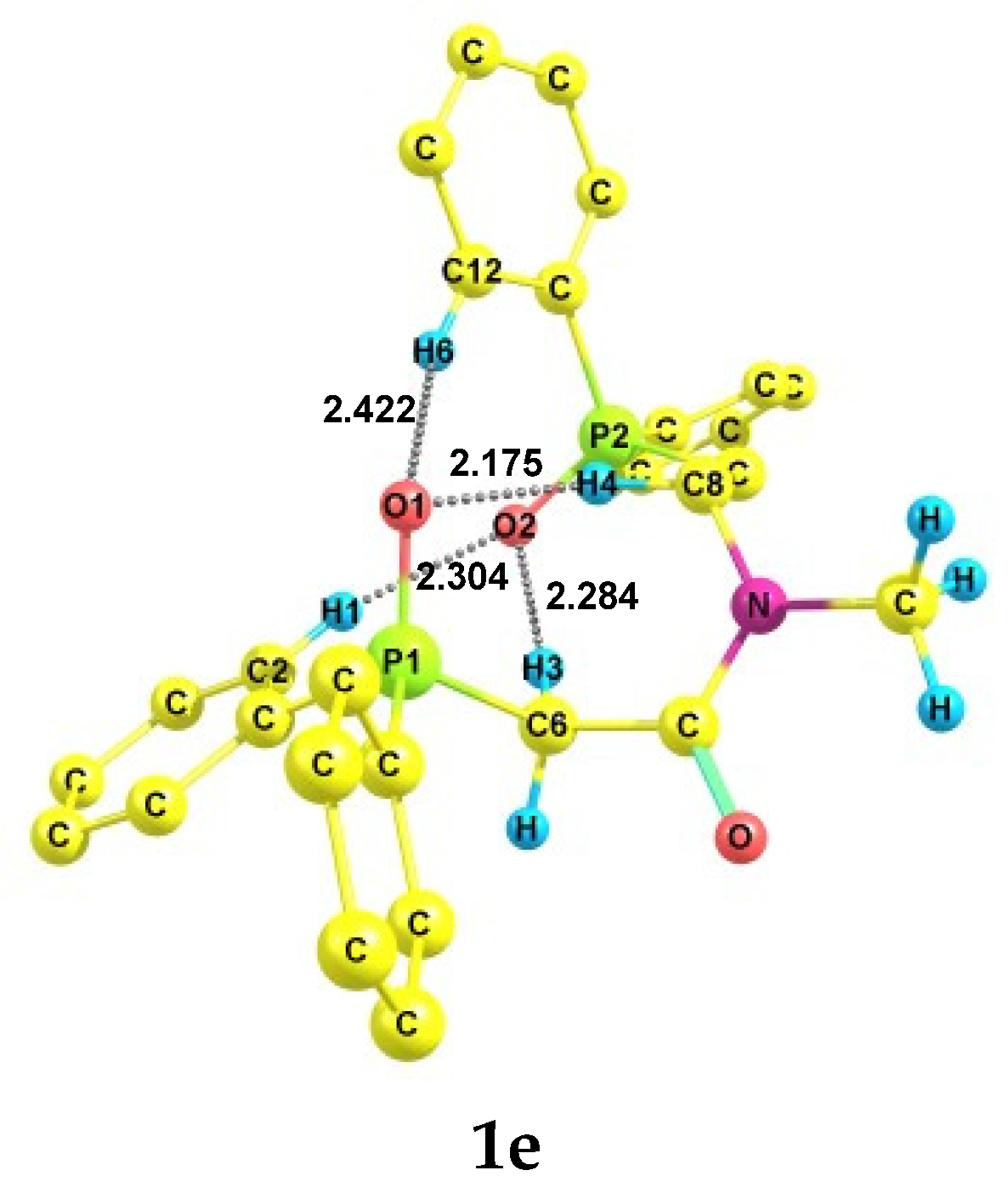
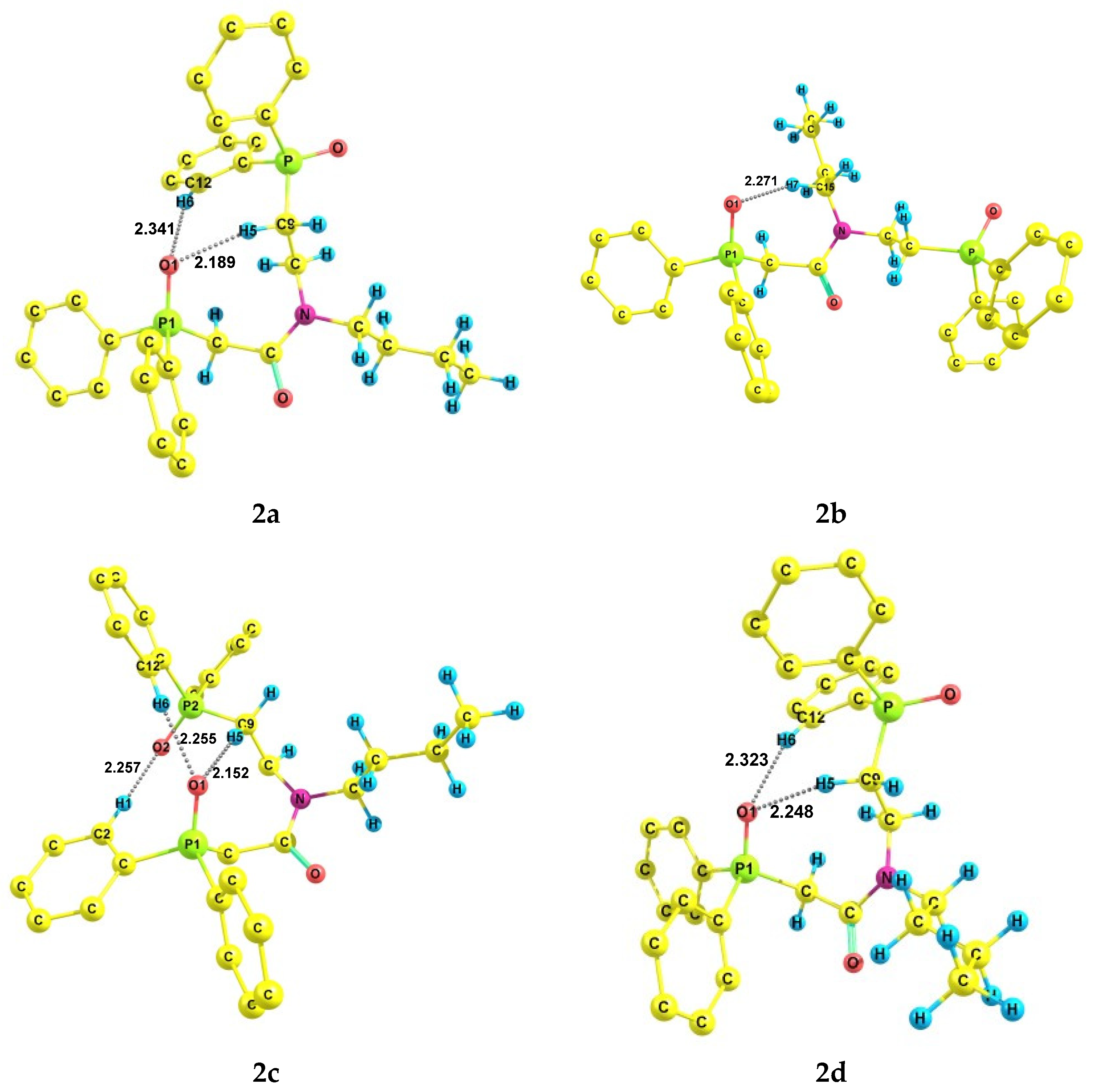
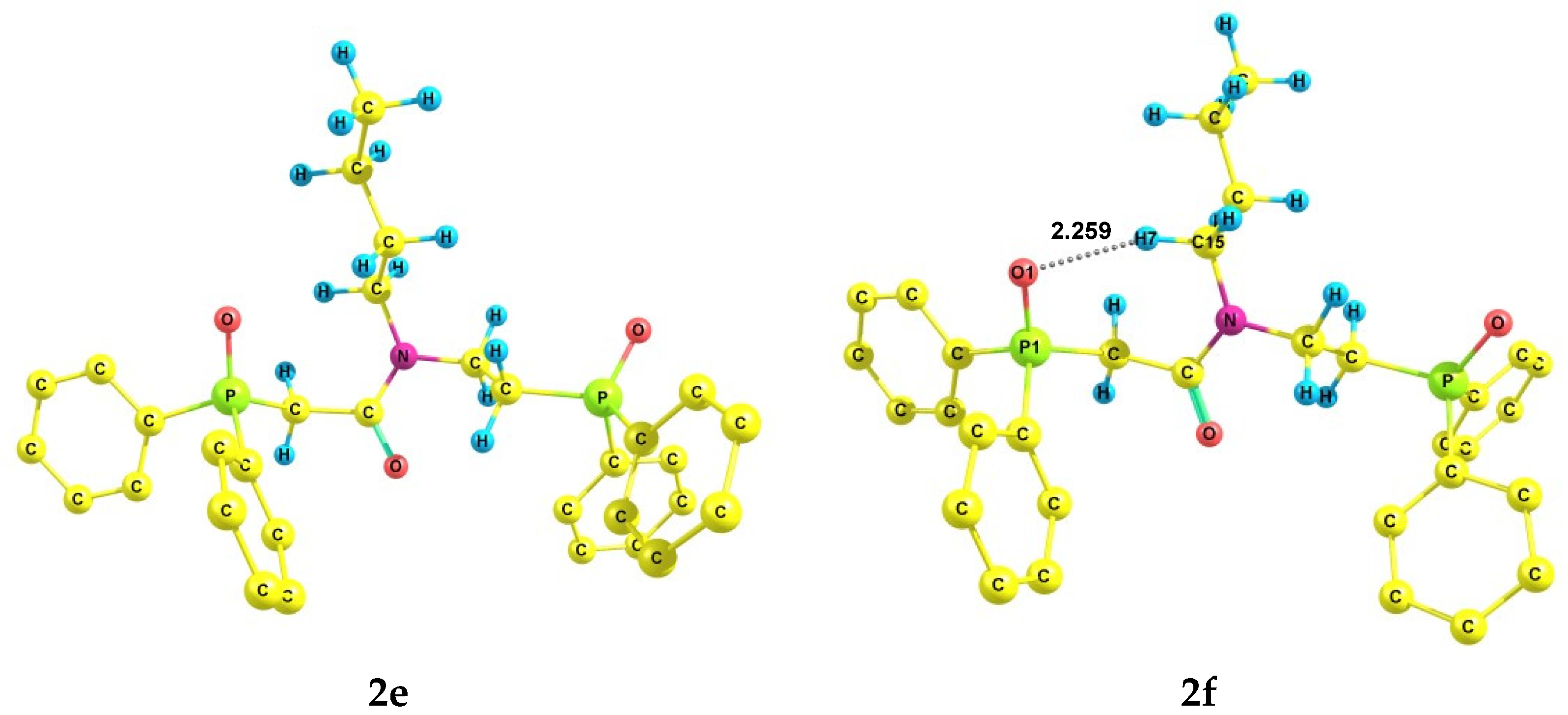
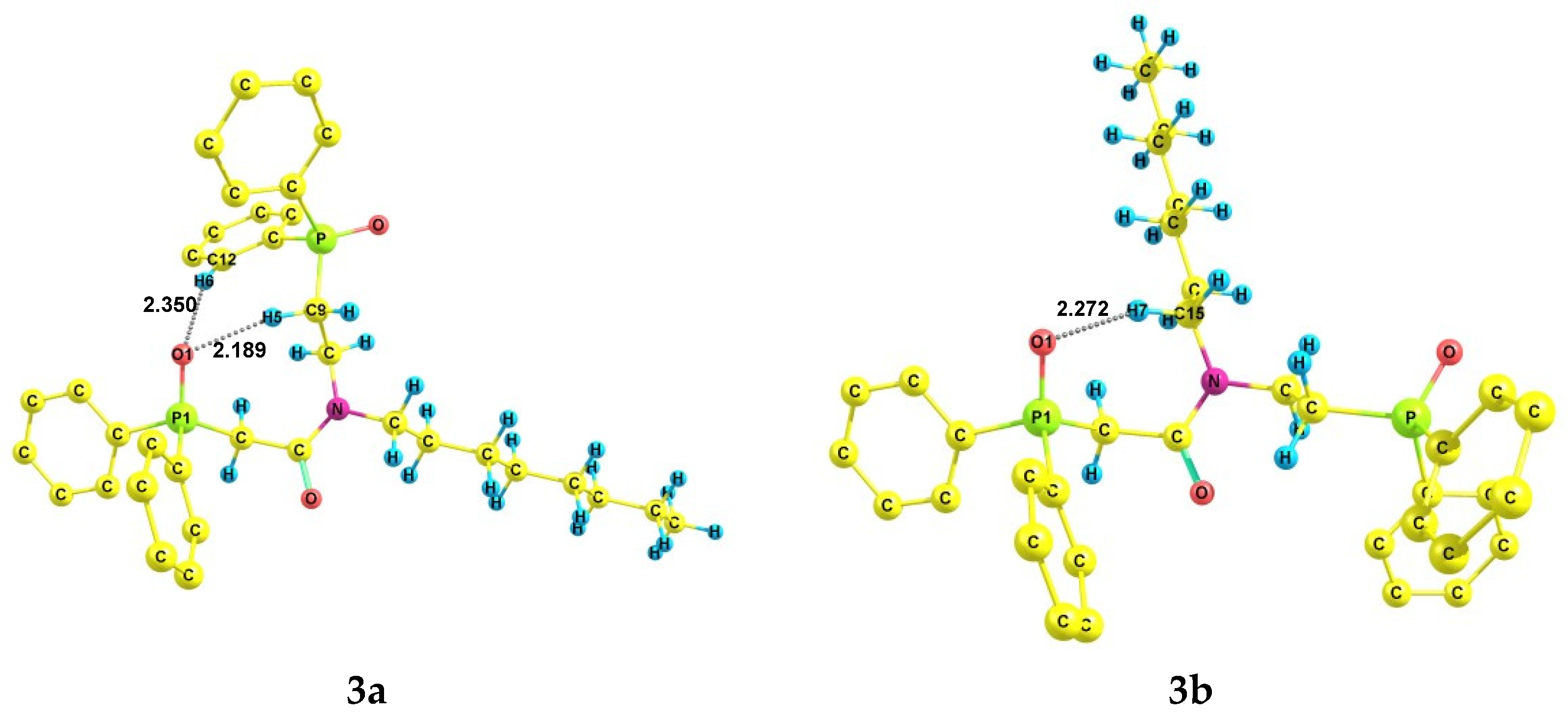
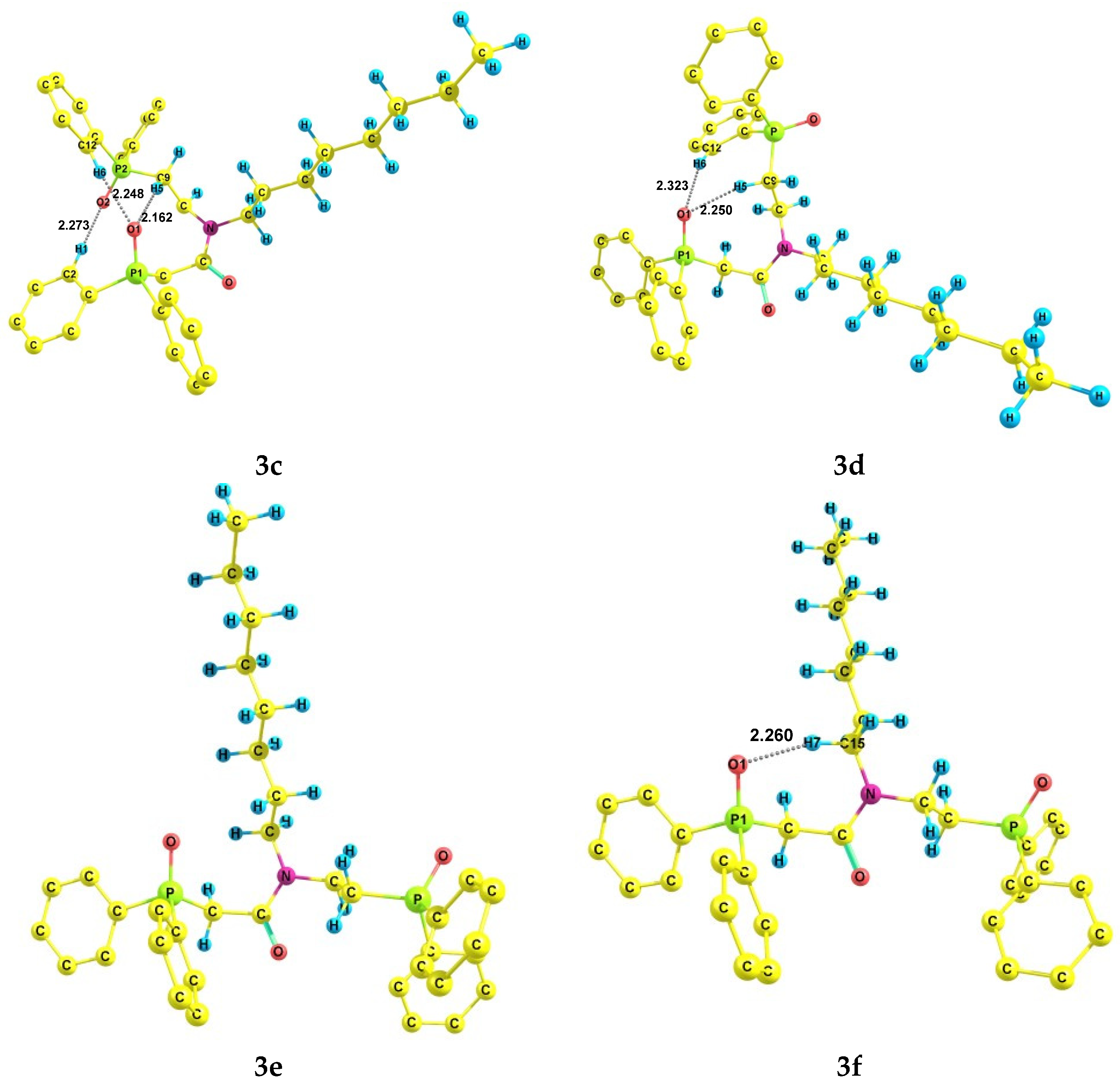
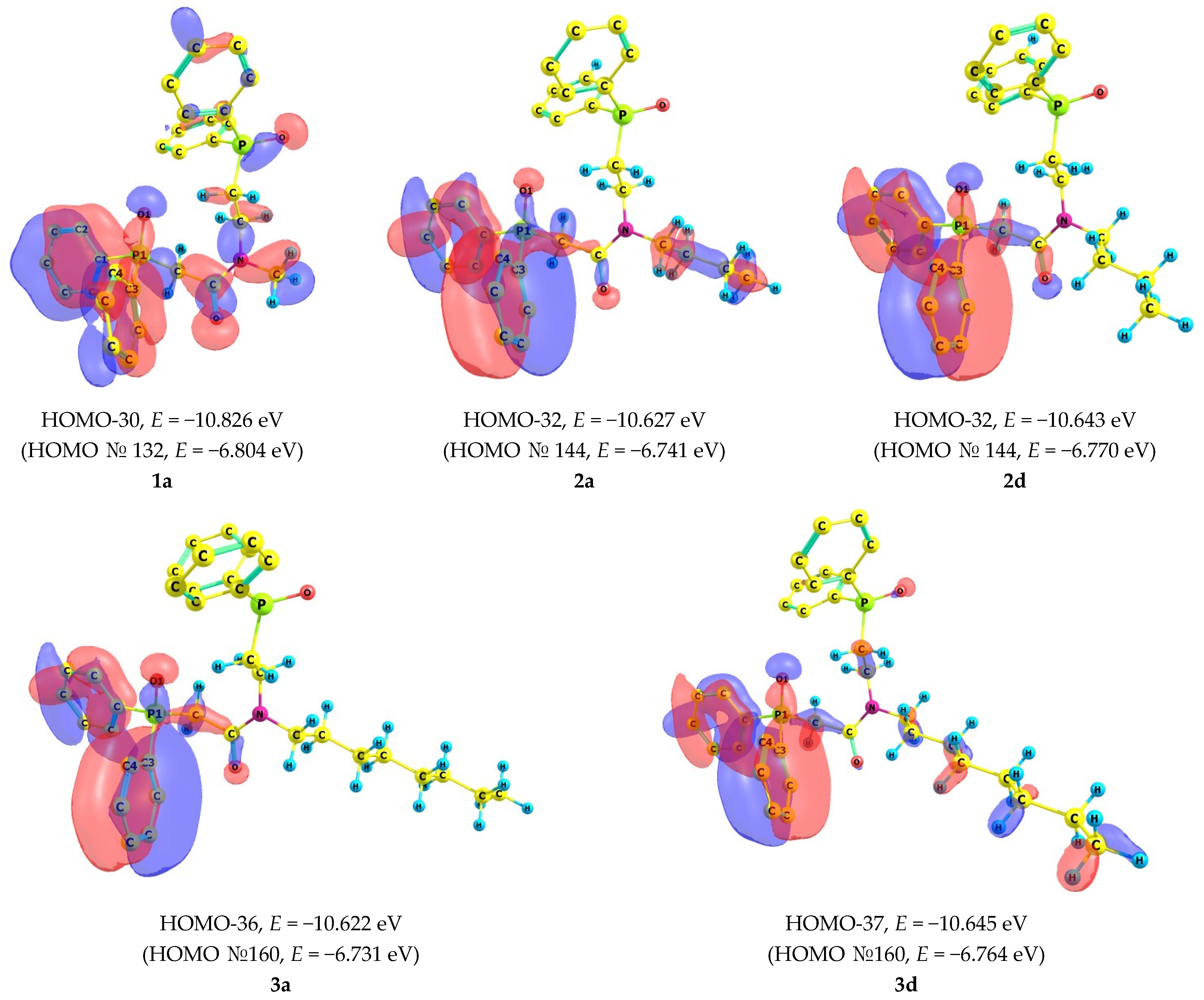
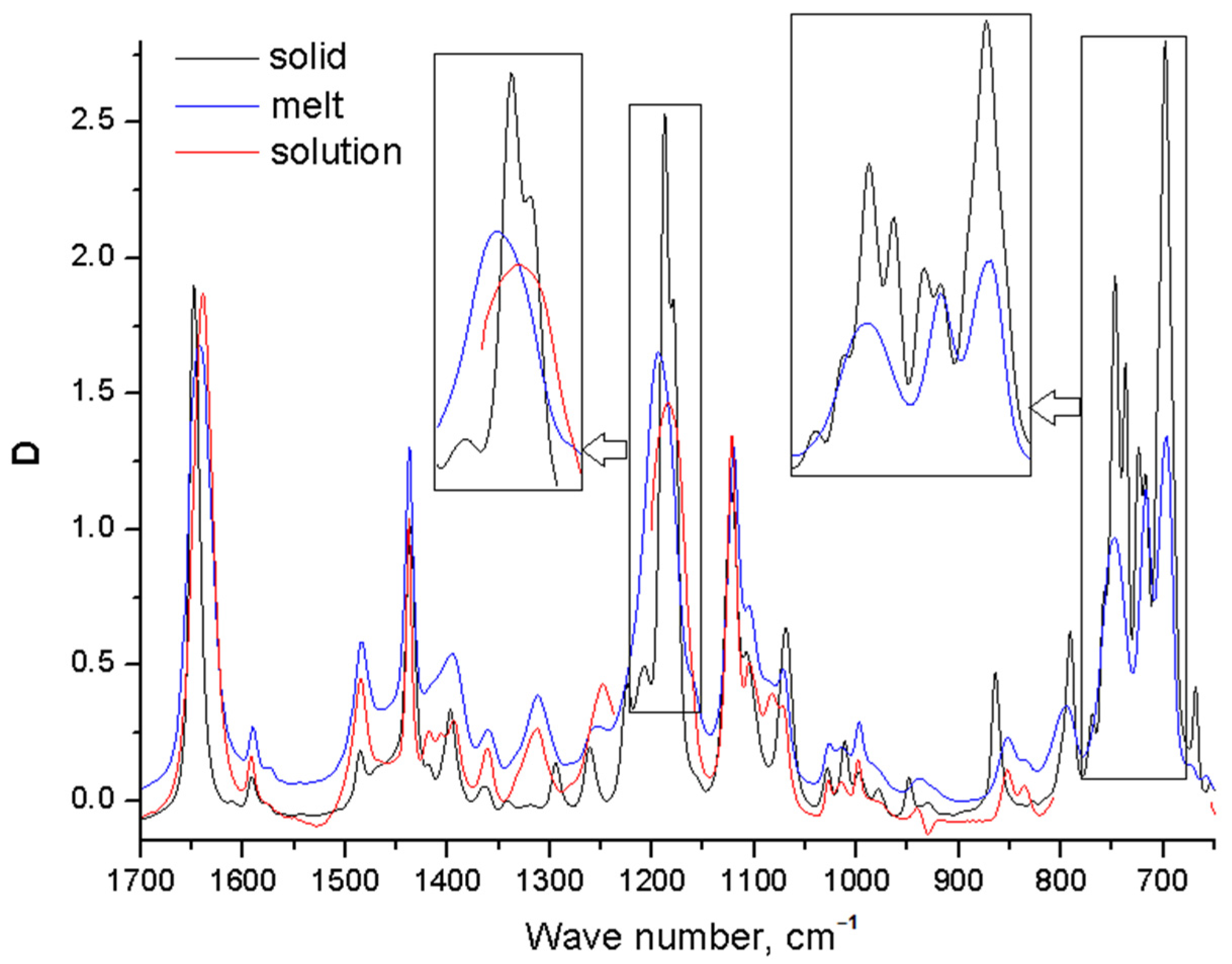
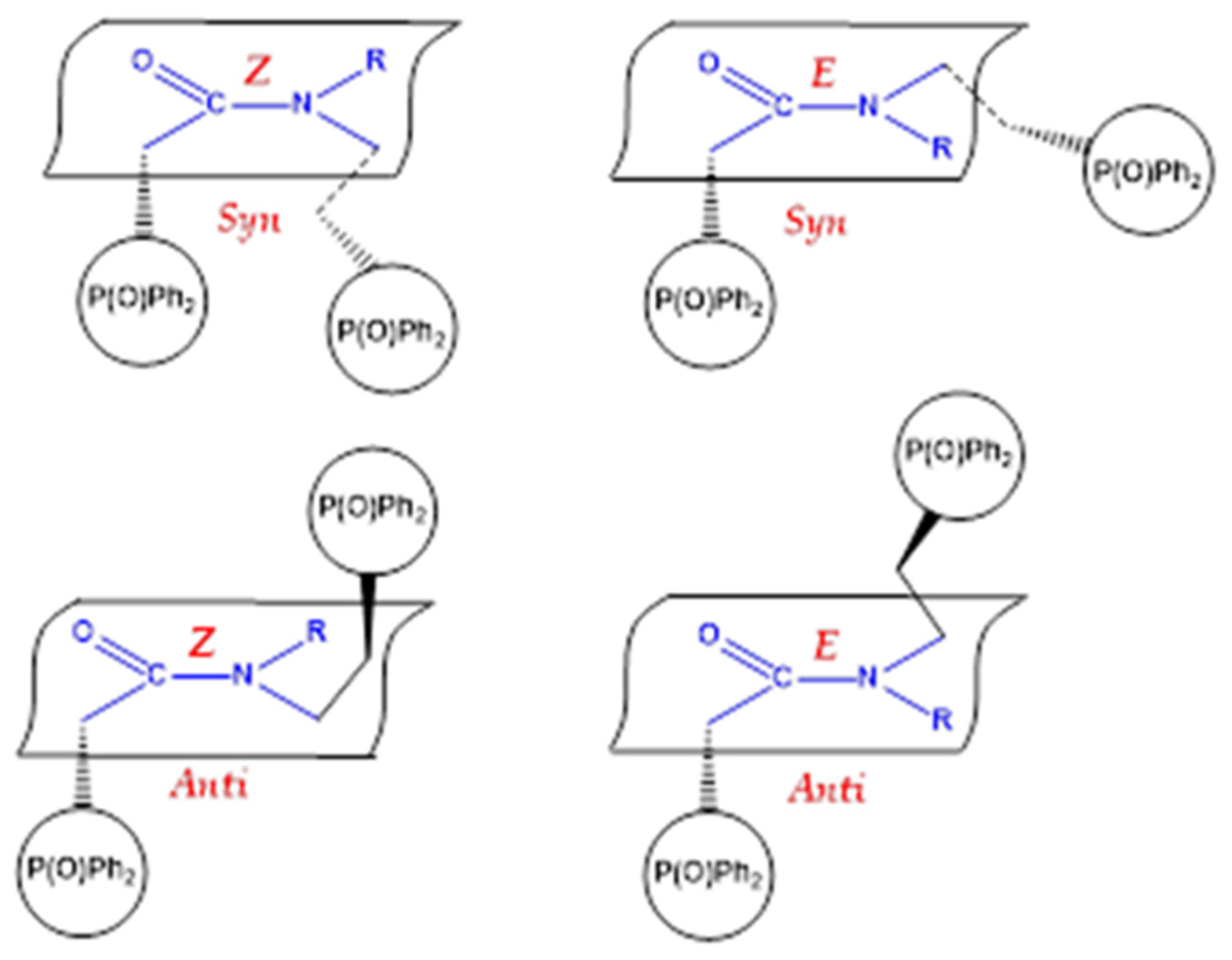
| Compound | α | γ | Por., cm3 | μ, D |
|---|---|---|---|---|
| 1 | 6.106 | 0.303 | 547.82 | 5.15 |
| 2 | 5.070 | 0.214 | 496.84 | 4.90 |
| 3 | 4.091 | 0.259 | 432.32 | 4.77 |
| Conformer | ΔE | ΔG | μtheor | μcalc | n, % | |
|---|---|---|---|---|---|---|
| 1a | Z, syn | 0.0 | 0.0 | 5.67 | 4.75 | 41.3 |
| 1b | E, syn | 1.5 | 0.4 | 5.44 | 5.15 | 35.3 |
| 1c | Z, syn | 2.9 | 8.2 | 1.72 | 1.77 | 1.5 |
| 1d | E, anti | 3.7 | 1.6 | 5.53 | 5.84 | 21.5 |
| 1e | Z, anti | 5.6 | 11.5 | 3.74 | 3.40 | 0.4 |
| 2a | Z, syn | 0.0 | 2.1 | 5.48 | 4.74 | 23 |
| 2b | E, syn | 1.6 | 0.0 | 5.22 | 5.33 | 55 |
| 2c | Z, syn | 3.0 | 9.8 | 2.35 | 2.05 | 1 |
| 2d | Z, syn | 3.4 | 5.7 | 5.71 | 4.77 | 6 |
| 2e | E, syn | 5.1 | 6.0 | 5.54 | 5.51 | 5 |
| 2f | E, anti | 5.4 | 4.3 | 5.30 | 5.80 | 10 |
| 3a | Z, syn | 0.0 | 1.8 | 5.44 | 4.75 | 21 |
| 3b | E, syn | 1.5 | 0.0 | 5.18 | 5.43 | 43 |
| 3c | Z, syn | 2.9 | 9.3 | 2.34 | 2.28 | 1 |
| 3d | Z, syn | 3.4 | 5.0 | 5.69 | 4.32 | 6 |
| 3e | E, syn | 5.0 | 3.8 | 5.55 | 5.44 | 9 |
| 3f | E, anti | 5.3 | 2.0 | 5.27 | 5.80 | 20 |
| α | β | γ | δ | ε | ζ | η | Θ | ι | κ | λ | |
|---|---|---|---|---|---|---|---|---|---|---|---|
| 1a | −1 | 22 | 82 | 93 | 0 | - | −84 | 168 | −65 | −14 | 7 |
| 1b | 6 | 24 | 75 | 99 | −178 | - | 100 | −179 | 60 | 8 | 31 |
| 1c | 59 | 12 | 47 | 89 | −2 | - | −73 | −166 | 41 | 72 | 5 |
| 1d | 7 | 25 | 77 | 104 | 173 | - | −94 | 178 | −61 | −30 | −9 |
| 1e | 61 | 15 | 71 | 100 | 3 | - | 80 | 134 | −58 | 36 | 17 |
| 2a | −1 | 22 | 82 | 92 | 0 | 87 | −84 | 167 | −65 | −15 | 7 |
| 2b | 6 | 25 | 74 | 97 | −179 | −97 | 100 | −178 | 60 | 8 | 31 |
| 2c | 59 | 12 | 59 | 76 | −3 | −84 | −92 | −153 | 49 | 72 | 5 |
| 2d | −2 | 22 | 79 | 95 | −1 | −77 | −79 | 168 | −67 | −15 | 7 |
| 2e | 7 | 26 | 74 | 98 | −179 | −97 | 100 | −179 | 60 | 9 | 31 |
| 2f | 6 | 24 | 77 | 100 | −179 | −102 | −109 | 179 | −60 | −30 | −8 |
| 3a | −1 | 22 | 81 | 92 | −1 | 87 | −84 | 168 | −65 | −14 | 7 |
| 3b | 6 | 25 | 74 | 97 | −179 | −96 | 100 | −178 | 60 | 8 | 31 |
| 3c | 58 | 13 | 60 | 76 | −3 | −84 | −91 | −153 | 49 | 70 | 5 |
| 3d | −1 | 23 | 79 | 95 | −1 | −77 | −79 | 167 | −68 | −15 | 6 |
| 3e | 8 | 26 | 75 | 103 | 179 | 121 | 108 | −179 | 60 | 8 | 31 |
| 3f | 6 | 25 | 77 | 100 | −179 | −101 | −108 | 179 | −60 | −29 | −7 |
| H5⋯O1 | C9–H5⋯O1 | H6⋯O1 | C12–H6⋯O1 | |
|---|---|---|---|---|
| 1a | 2.194 | 153 | 2.339 | 164 |
| 1b | 2.247 * | 151 * | ||
| 1c | 2.160 | 144 | 2.305 | 157 |
| 1d | 2.236 | 152 | ||
| 1e | 2.175 ** | 152 ** | 2.422 | 154 |
| 2a | 2.189 | 154 | 2.341 | 164 |
| 2b | 2.271 * | 153 * | ||
| 2c | 2.152 | 162 | 2.255 | 172 |
| 2d | 2.248 | 147 | 2.323 | 163 |
| 2e | 2.259 * | 153 * | ||
| 2f | 2.189 | 154 | 2.350 | 163 |
| 3a | 2.272 * | 153 * | ||
| 3b | 2.162 | 161 | 2.248 | 172 |
| 3c | 2.250 | 147 | 2.323 | 163 |
| 3d | 2.260 * | 153 * | ||
| 3f | 2.194 | 153 | 2.339 | 164 |
| P=O | C=O | |||||
|---|---|---|---|---|---|---|
| 1 | 2 | 3 | 1 | 2 | 3 | |
| νexp solid | 1179, 1188 | 1187 | 1181 | 1648 | 1642 | 1632 |
| νexp melt | 1194 | 1194 | 1195 | 1643 | 1640 | 1641 |
| νexp solution | 1184 | 1184 | 1182 | 1639 | 1639 | 1634 |
| νtheor a | 1178, 1187 | 1177, 1182, 1194 | 1179, 1184, 1187 | 1650 | 1644 | 1644 |
| νtheor b | 1187, 1192 | 1190, 1193 | 1188, 1192, 1193 | 1642 | 1639 | 1639 |
| νtheor c | 1193 | 1162, 1175 | 1162, 1175 | 1641 | 1652 | 1652 |
| νtheor d | 1171, 1181 | 1179, 1181, 1191 | 1179, 1184 | 1647 | 1643 | 1643 |
| νtheor e | 1180, 1183 | 1190, 1194 | 1191, 1194 | 1659 | 1632 | 1632 |
| νtheor f | - | 1190, 1193 | 1192, 1193 | - | 1635 | 1635 |
Publisher’s Note: MDPI stays neutral with regard to jurisdictional claims in published maps and institutional affiliations. |
© 2021 by the authors. Licensee MDPI, Basel, Switzerland. This article is an open access article distributed under the terms and conditions of the Creative Commons Attribution (CC BY) license (https://creativecommons.org/licenses/by/4.0/).
Share and Cite
Kuznetsova, A.; Chachkov, D.; Artyushin, O.; Bondarenko, N.; Vereshchagina, Y. Conformational Analysis of N-Alkyl-N-[2-(diphenylphosphoryl)ethyl]amides of Diphenylphosphorylacetic Acid: Dipole Moments, IR Spectroscopy, DFT Study. Molecules 2021, 26, 4832. https://doi.org/10.3390/molecules26164832
Kuznetsova A, Chachkov D, Artyushin O, Bondarenko N, Vereshchagina Y. Conformational Analysis of N-Alkyl-N-[2-(diphenylphosphoryl)ethyl]amides of Diphenylphosphorylacetic Acid: Dipole Moments, IR Spectroscopy, DFT Study. Molecules. 2021; 26(16):4832. https://doi.org/10.3390/molecules26164832
Chicago/Turabian StyleKuznetsova, Anastasiia, Denis Chachkov, Oleg Artyushin, Natalia Bondarenko, and Yana Vereshchagina. 2021. "Conformational Analysis of N-Alkyl-N-[2-(diphenylphosphoryl)ethyl]amides of Diphenylphosphorylacetic Acid: Dipole Moments, IR Spectroscopy, DFT Study" Molecules 26, no. 16: 4832. https://doi.org/10.3390/molecules26164832
APA StyleKuznetsova, A., Chachkov, D., Artyushin, O., Bondarenko, N., & Vereshchagina, Y. (2021). Conformational Analysis of N-Alkyl-N-[2-(diphenylphosphoryl)ethyl]amides of Diphenylphosphorylacetic Acid: Dipole Moments, IR Spectroscopy, DFT Study. Molecules, 26(16), 4832. https://doi.org/10.3390/molecules26164832







